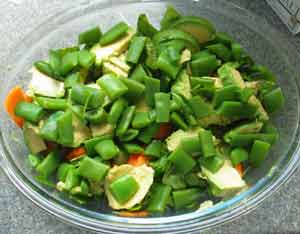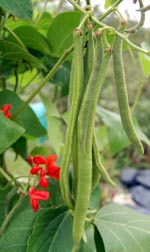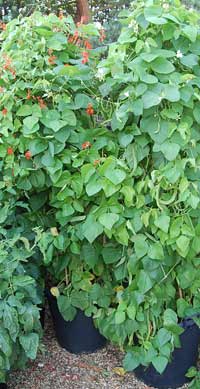Growing Beans for Bumper Crops!

Green bean and avocado salad
Beans, beans... good for your heart... goes the rather disreputable children's ditty. But beans are good for us. And growing beans is easy to do in your backyard or garden.
Here's some details on growing beans at home
Beans are ridiculously easy to grow and provide a nutritious and tasty crop. They provide useful amounts of vitamins A, C and E, as well as niacin and iron. They have the added advantage of being very bountiful. Most varieties perform and produce all summer long.
Here's how to grow beans - some of the common types and one or two interesting varieties, too.
Growing runner beans
Runner beans can make a good contribution to green living, helping us to reduce our food miles. They also make great gifts for neighbours and friends as they are so bountiful.
This plant must have nourished fantasies of easy living in people living in medieval times, as magic beans feature so strongly in folk and fairy tales. Just think of Jack and the beanstalk he grew from a magic bean!
In real life the bean stalk does indeed grow at a prodigious rate, curling skywards up any handy support.
Children are often very impressed by these plants, even these days, when commonplace plants must compete with the latest electronic gizmos!
The beautiful flowers, red or white, are followed by weeks and weeks of productive life right into autumn.
Runners are not always to everyone's taste, being sometimes rather stringy.
The secret is to pick them while they are young and tender. Also, some varieties are better than others and may be marketed as "stringless".
Runner beans can be cooked whole - or, when the crop is getting large and prolific, use them shelled for a pleasant (and stringless) change. If you keep picking them more will develop so you can have young, tender beans all summer long.
You can now buy runner beans and other types, including heirloom beans at Amazon:
How to grow runner beans

Grow them to start in medium sized pots or boxes of potting compost. The "seed" is quite large, and they develop deep roots quite quickly. Place the seed about 1" below the surface of the soil or growing medium.
Try to put them upright - this way they are less likely to rot. If you put them in upside down, they will right themselves but it will slow down their early growth a little.
Firm the compost down and water them well. Keep the compost moist but not soaking wet.
They will quickly grow and should be planted out before they become pot-bound (too big for the pot - roots sticking out of the bottom).
Harden off before planting out
Harden them off for a few days before planting out. (Stand them outside for a few hours each day so that they gradually get used to the lower outdoor temperatures.) Plant them out about 8-10 inches apart and next to a frame to climb up. Frames are easy to make.
Take tall bamboo or hazel poles and create a tepee-like structure by pushing the poles into the soil to form a circle. Each pole should be about a foot away from the next one. Bring the poles together in the middle and tie them together.
If you want to be eco-friendly it is good to use a native species for your bean poles. In Europe hazel is a good choice, being reasonably strong and straight. Some garden centres sell these for a small sum. You can cut your own if you have access to hazel trees.
This is more environmentally-friendly than using bamboo canes brought in from China (unless you happen to live in China, of course!)
Now you can use garden twine to weave the poles together more firmly. It is easiest to work from the top downwards. Finish about 10 - 15 cm from the ground. The plants will quickly latch onto the support and grow up it. You can put plants on either side of each pole and they will happily climb up together.
The trick is to keep them well fed and watered but if your soil is good and the weather is warm with some rainfall, you may not have to do very much at all!
Once the plants have developed their pretty red or white flowers, the seed pods will start to form not long after. All you have to do is keep up with the picking! Once they start producing they will carry on until the winter frosts stop them.
Extra beans can be blanched and frozen.
Pole beans and French beans

Pole beans are similarly easy to grow and as the name suggests grow up poles or other supports.
Some of these are my favourites. Although they are a bit demanding (only the providing support, really) they are just so productive!
There is a pole bean called "Trail of Tears" which delivers immense crops of sweet, soft beans which you can also dry for later use. The Cherokee Indians used to carry these beans around with them wherever they went.
Many pole bean varieties crop well.As you can see from the picture, right, it is possible to grow some varieties of beans in large pots. They will do well, provided that the pot is big enough and you water them copiously. The soil or compost also needs to be good.
French beans
French beans can be much smaller bushes needing only minimal support to keep them upright. Some of these can be pretty productive too. They tend to be tender and tasty and not very demanding to grow.
I find it easiest to start them off in pots under shelter.
Plant them out with ample room to grow once the danger of frost is passed. Growing beans like these is very rewarding and there are lots of interesting varieties to try.
Fava beans or broad beans
Then there's the broad bean or "fava" bean. (These are basically the same as field or horse beans but the stock has been improved for horticultural use.)
Fava beans are a little trickier to grow than most beans as they are started earlier in the year and can become victim to cold winds and other difficult growing conditions. They are not generally as productive as pole beans.
However the taste can be absolutely fantastic, making them well worth the effort. They are also versatile staples for the organic kitchen, especially if you enjoy soups and stews.
We use broad beans a great deal in early summer as they ripen. The flavour is incomparable and you can even cook the young ones in their pods.
These beans and others are also available through Amazon.
How to grow fava beans (broad beans)
Broad beans can be started in pots or directly in the ground either in autumn or spring. Pots can be started on windowsills or in a cold greenhouse for a surer start.
Put one or two beans into good quality potting compost. Place the beans in the medium so that they are standing upright. This way they are less likely to rot. You can also pre-soak them for a few days if you like, to get them started before you put them into pots - this makes it easier to see which way up they are!
The seedlings should emerge vigorously after a few days. Keep them well watered but not sodden. When they are about 4-6 inches tall (10-15cms) it's time to think about hardening them off and planting them out. Give them a few days of exposure to outside temperatures, bringing them in at night when the temperature falls.
When you have done this for a few days (preferably two weeks, especially if the weather is still at all chilly), choose a mild, damp day to plant them out in their growing positions. Give them a reasonable amount of room, depending upon the variety, 8-10 inches at least. Rows need to be about 12 -15 inches apart.
Water them well and firm them down. You may want to cover them in fleece to begin with.
They should now grow on without problems, provided that you keep the ground reasonably free of competing weeds.
They may suffer attack from rodents and as the flower heads develop, blackfly can become a problem.
Use marigolds as companion plants to help reduce aphid attacks. Marigolds attract hover flies and other beneficial insects that eat aphids. Potatoes are also supposed to be a good companion crop to broad beans.
There's good anecdotal evidence that planting beans in autumn - rather than spring - helps reduce blackfly attacks. This is likely because the plant matures earlier, avoiding the main blackfly season.
Broad beans are legumes and will fix nitrogen in the soil, making them a useful crop for improving the soil fertility. They also have quite deep roots so they can help bring nutrients up from deep in the soil.
Some organic growers use them almost as much for their soil improving qualities as for the crop.
Cooking with beans
If you grow beans with moderate success it is easy enough to have sufficient to keep for starting next year's crop.
You can also bag and freeze most beans for use during the winter. Broad beans are especially nice kept for adding to soups and stews. They impart a subtle flavour and a rich dense texture which can be very satisfying.
Here is the definitive work on cooking with beans of all kinds:
Heirloom Beans: Great Recipes for Dips and Spreads, Soups and Stews, Salads and Salsas, and Much More from Rancho Gordo will certainly satisfy your curiosity about bean cuisine and give you plenty of inspiration should you enjoy a bumper crop of beans from your garden. Pretty useful if you are using dried pulses or even tinned beans, too!
From "Beans for Bumper Crops" back to Green Grow - Organic Vegetable Gardening
Greenfootsteps Home - for more easy green living ideas
| Tweet |

| Tweet |


Some related pages:
Planting peas for a popular home crop
Footprints
- an occasional e-zine from Greenfootsteps
If you would like to receive the e-zine, please just sign up below.






New! Comments
Have your say about what you just read! Leave me a comment in the box below.